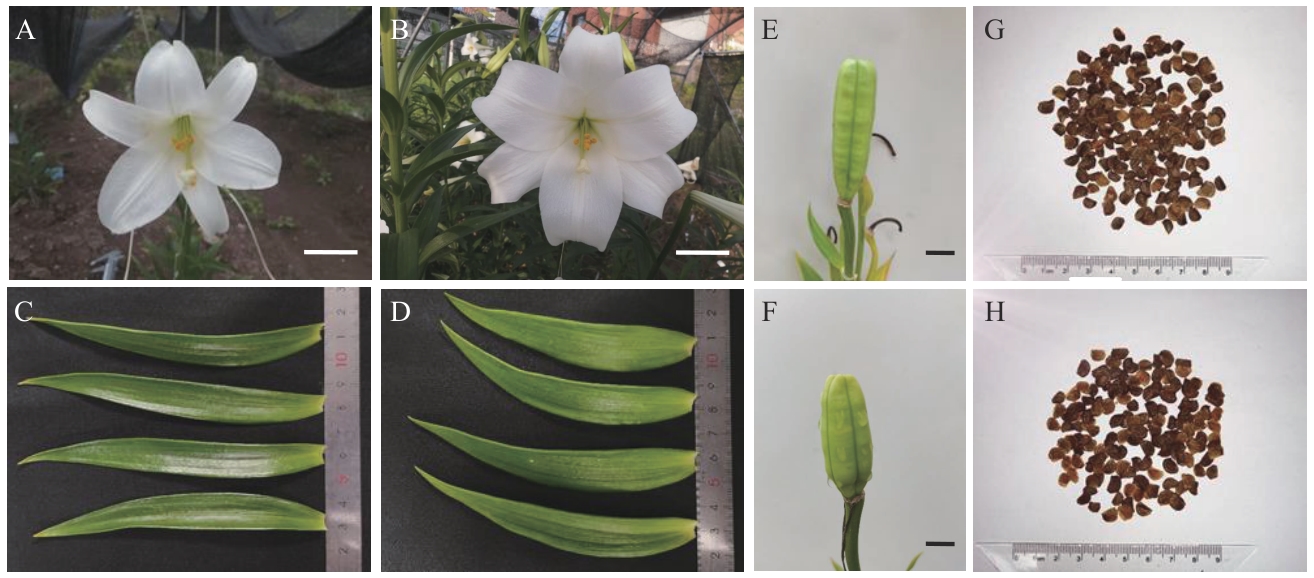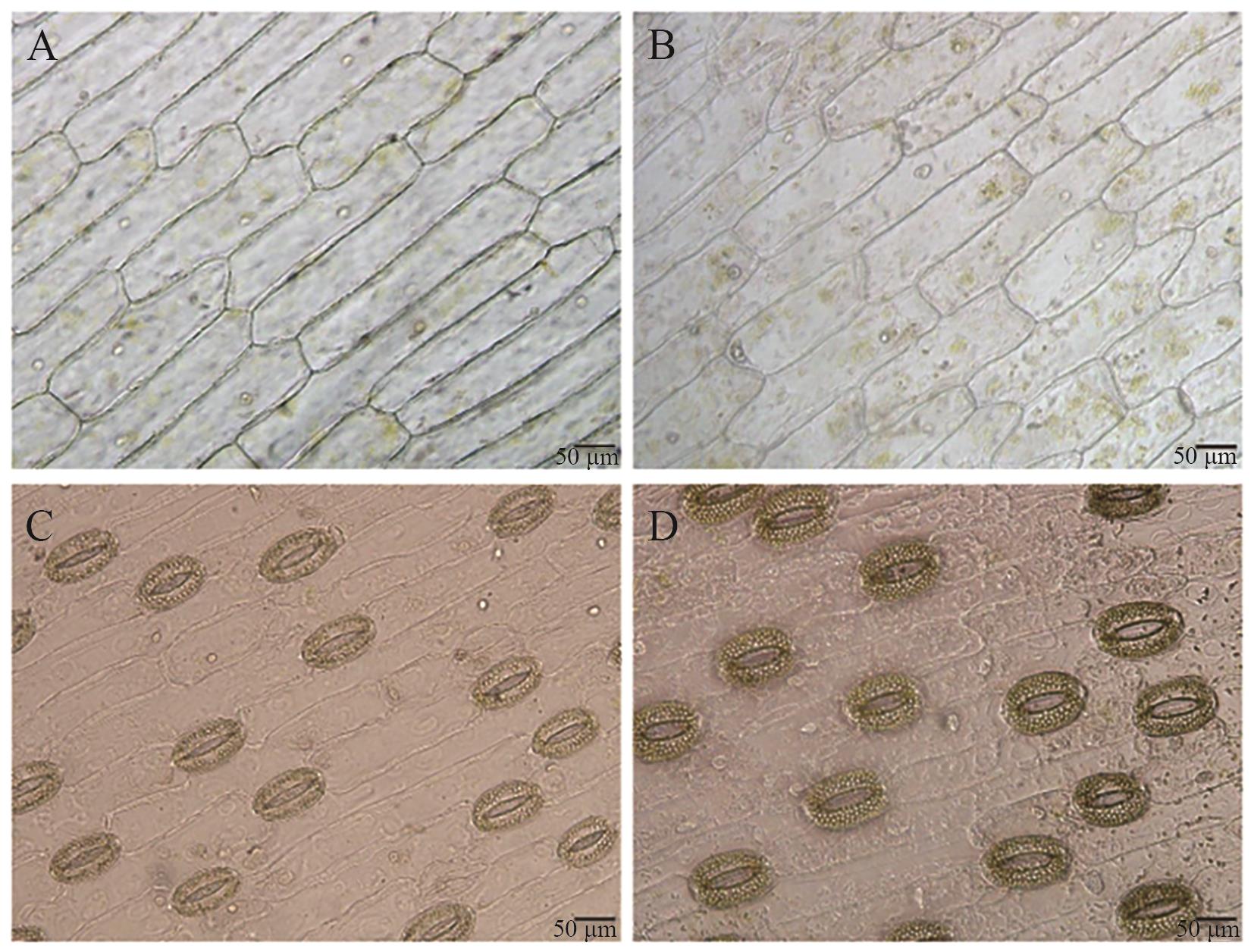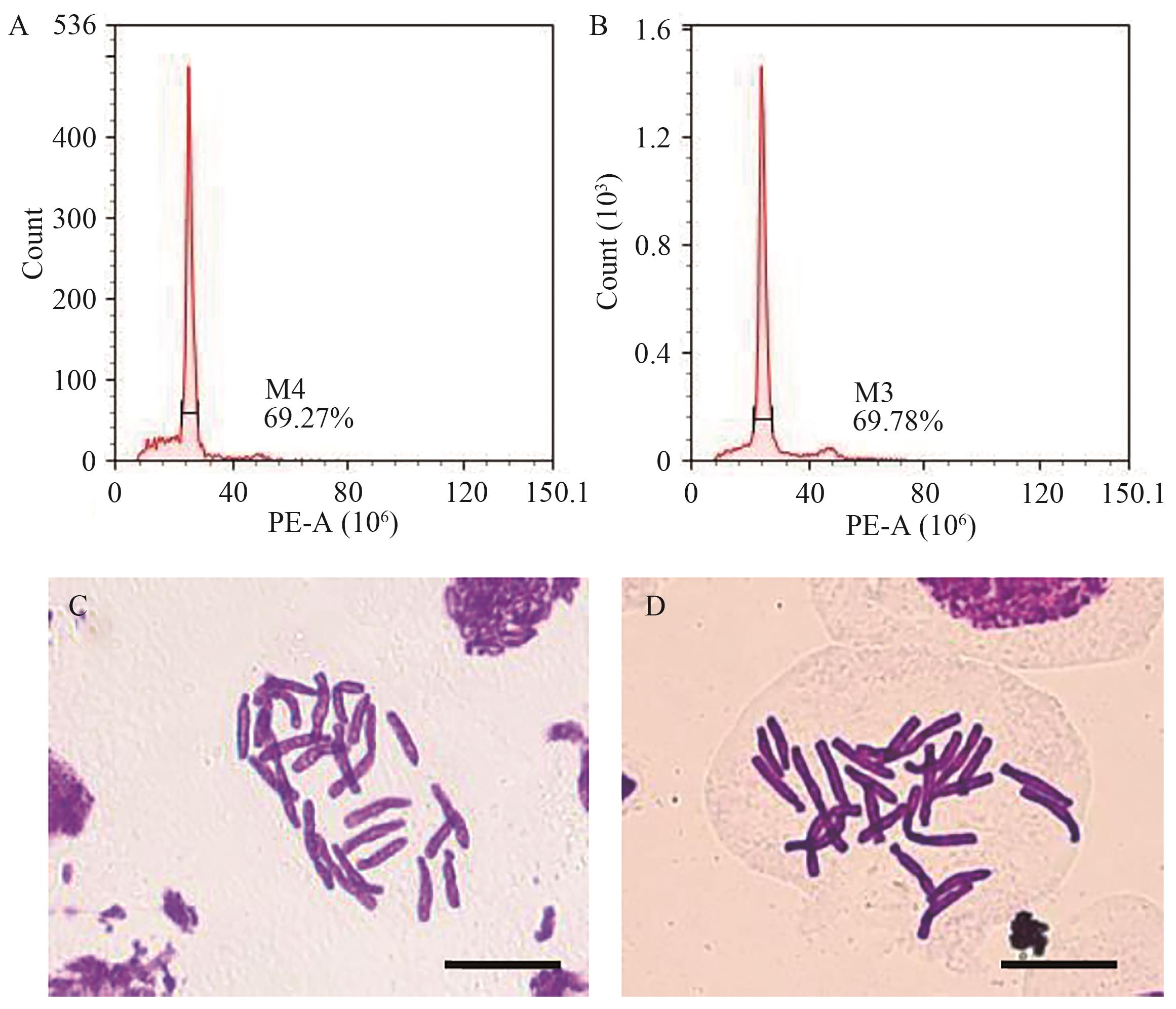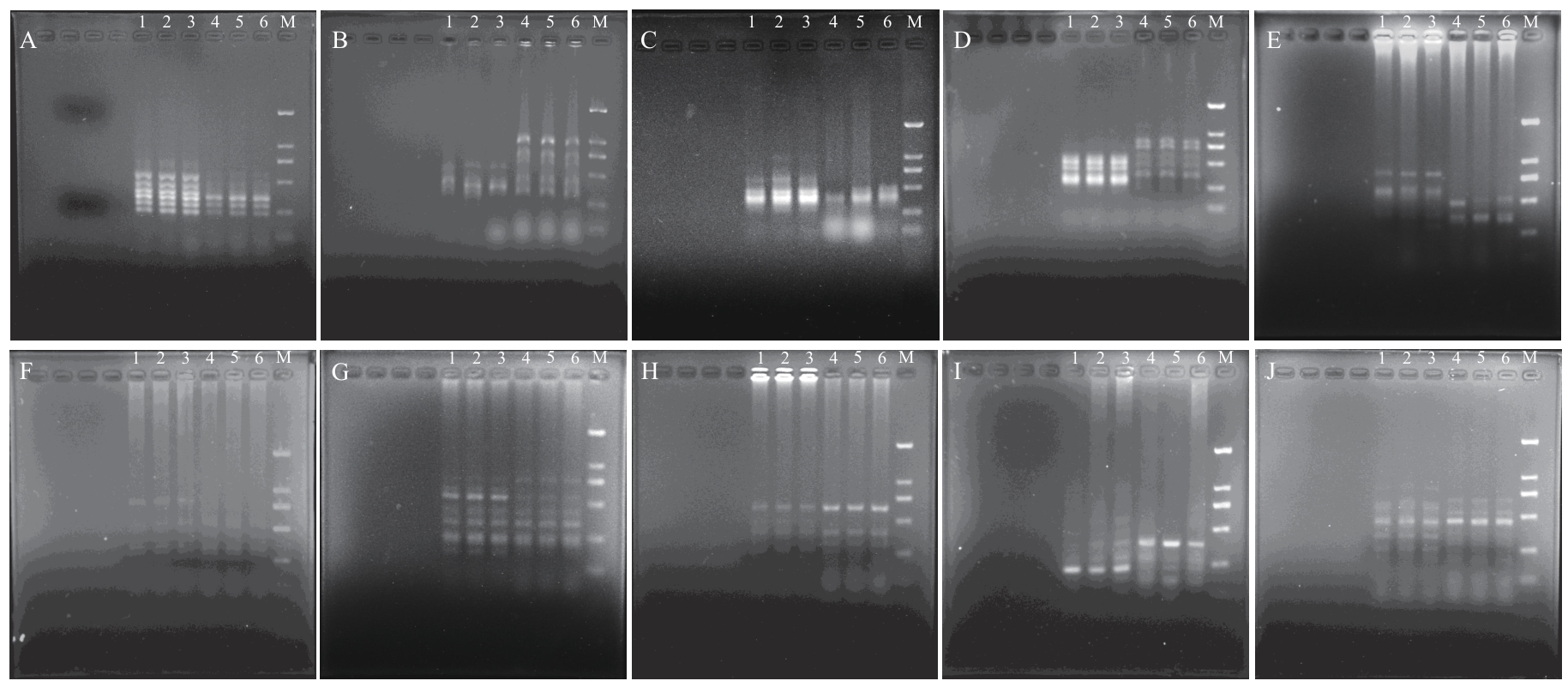








生物技术通报 ›› 2025, Vol. 41 ›› Issue (3): 219-229.doi: 10.13560/j.cnki.biotech.bull.1985.2024-0798
• 研究报告 • 上一篇
程诗袁( ), 何佳丽, 韩福彬, 杨娜娜, 杨利平, 符勇耀(
), 何佳丽, 韩福彬, 杨娜娜, 杨利平, 符勇耀( )
)
收稿日期:2024-08-17
出版日期:2025-03-26
发布日期:2025-03-20
通讯作者:
符勇耀,男,博士,副教授,研究方向 :百合种质创新与逆境生理机制;E-mail: yongyaofu@yznu.edu.cn作者简介:程诗袁,女,研究方向 :百合染色体核型分析;E-mail: 3086165208@qq.com
基金资助:
CHENG Shi-yuan( ), HE Jia-li, HAN Fu-bin, YANG Na-na, YANG Li-ping, FU Yong-yao(
), HE Jia-li, HAN Fu-bin, YANG Na-na, YANG Li-ping, FU Yong-yao( )
)
Received:2024-08-17
Published:2025-03-26
Online:2025-03-20
摘要:
目的 ‘雪皇后’属于麝香百合杂种系品种,明确麝香百合和‘雪皇后’之间的差异,为二者的鉴定和开发利用奠定基础。 方法 采用经典测量、染色体压片和ISSR标记方法对其形态特征、核型以及遗传学变异进行系统分析。 结果 形态学观察结果发现,麝香百合的叶片比‘雪皇后’显著变窄,果实略变长,而株高、开花口径、花期、鳞茎和外层鳞片重量等指标均无显著差异。‘雪皇后’花粉粒投影面积大于麝香百合,以分布在8 700-8 900 μm2的花粉粒数目最多(占比14.4%)。‘雪皇后’叶片上表皮细胞和气孔比麝香百合显著变宽。核型分析显示,麝香百合与‘雪皇后’的染色体数目均为2n=2x=24,为二倍体,麝香百合核型公式为2n=2x=24=2m+6sm+10st+6t,‘雪皇后’核型公式为2n=2x=24=2m+4sm+16st(2SAT)+2t,且后者核不对称系数更大。ISSR标记表明,与麝香百合相比,‘雪皇后’发生了遗传变异,变异率为20.00%。 结论 麝香百合与‘雪皇后’在叶片形态、花粉粒、核型以及分子遗传水平上存在显著差异。
程诗袁, 何佳丽, 韩福彬, 杨娜娜, 杨利平, 符勇耀. 麝香百合和‘雪皇后’的形态特征、核型及ISSR标记分析[J]. 生物技术通报, 2025, 41(3): 219-229.
CHENG Shi-yuan, HE Jia-li, HAN Fu-bin, YANG Na-na, YANG Li-ping, FU Yong-yao. Morphological Characterization, Karyotype and ISSR Marker of Lilium longiflorum and L. longiflorum ‘Snow Queen’[J]. Biotechnology Bulletin, 2025, 41(3): 219-229.

图1 麝香百合和‘雪皇后’植株形态比较A-B:花,bar=2.5 cm;C-D:叶片;E-F:膨大果实,bar=1 cm;G-H:有胚种子
Fig. 1 Comparison of plant morphology between L.longiflorum and L. longiflorum ‘Snow Queen’A-B: Flower, bar=2.5 cm. C-D: Leaf. E-F: Fruit, bar=1 cm. G-H: Embryo seeds
| 性状 Traits | 麝香百合 L. longiflorum | ‘雪皇后’ L. longiflorum ‘Snow Queen’ |
|---|---|---|
| 株高Plant height/cm | 49.79±1.43 | 48.72±1.43 |
| 茎粗Stem diameter/cm | 0.88±0.03 | 0.89±0.03 |
| 单株叶片数leaf number per plant | 51.37±3.16 | 55.27±2.29 |
| 叶长Leaf length/cm | 11.55±0.29 | 11.04±0.14 |
| 叶宽Leaf width/cm | 1.55±0.04 | 1.85±0.03** |
| 叶长宽比Leaf length-width ratio | 7.60±0.26** | 6.00±0.11 |
| 单朵花期Flowering time of a single flower/d | 6.55±0.11 | 6.70±0.15 |
| 花蕾长Bud length/cm | 15.54±0.43 | 14.93±0.34 |
| 花径Flower Path/mm | 10.64±0.42 | 11.62±0.23 |
| 花柄长Flower stalk length/cm | 10.19±0.24 | 11.13±0.23 |
| 花柄直径Flower stalk diameter/cm | 2.08±0.05 | 2.12±0.05 |
| 花丝长Filament length/cm | 11.42±0.17 | 12.65±0.05 |
| 花药长Anther length/cm | 1.23±0.04 | 1.22±0.01 |
| 花柱长Style length/cm | 12.44±0.19 | 14.20±0.23 |
| 花柱直径Style diameter/cm | 0.92±0.02 | 1.14±0.02 |
| 果实长Capsule length/cm | 6.10±0.18* | 5.55±0.12 |
| 果实直径Capsule diameter/cm | 1.90±0.12 | 1.80±0.13 |
| 单个果实有胚种子数Number of embro seeds per fruit | 42.45±7.08 | 33.50±6.21 |
| 单个果实无胚种子数Number of embro-free seeds per fruit | 246.18±30.96 | 303.75±29.78 |
| 单个果实种子数Number of total seeds per fruit | 288.64±35.57 | 337.25±32.15 |
| 种子长径 Seed length/ mm | 6.84±0.12 | 6.82±0.09 |
| 种子重量Seed weight/g/100 grain | 0.33±0.01 | 0.34±0.01 |
| 种球周径Bulb perimeter/cm | 17.36±0.28 | 17.15±0.25 |
| 种球重量Bulb weight/g | 64.32±1.76 | 64.30±1.94 |
| 外层鳞片重量Scale weight in the outer layer/g | 1.22±0.10 | 1.26±0.10 |
| 外层鳞片长Scale length in the outer layer/cm | 2.88±0.11 | 2.80±0.10 |
| 外层鳞片宽Scale width in the outer layer/cm | 1.67±0.07 | 1.71±0.05 |
| 外层鳞片长宽比Scale length-width ratio in the outer layer | 1.68±0.07 | 1.65±0.06 |
| 外层鳞片厚度Scale thickness in the outer layer/mm | 5.05±0.25 | 5.79±0.34 |
表1 麝香百合与‘雪皇后’的主要形态特征
Table 1 Main morphological characteristics in L. longiflorum and L. longiflorum ‘Snow Queen’
| 性状 Traits | 麝香百合 L. longiflorum | ‘雪皇后’ L. longiflorum ‘Snow Queen’ |
|---|---|---|
| 株高Plant height/cm | 49.79±1.43 | 48.72±1.43 |
| 茎粗Stem diameter/cm | 0.88±0.03 | 0.89±0.03 |
| 单株叶片数leaf number per plant | 51.37±3.16 | 55.27±2.29 |
| 叶长Leaf length/cm | 11.55±0.29 | 11.04±0.14 |
| 叶宽Leaf width/cm | 1.55±0.04 | 1.85±0.03** |
| 叶长宽比Leaf length-width ratio | 7.60±0.26** | 6.00±0.11 |
| 单朵花期Flowering time of a single flower/d | 6.55±0.11 | 6.70±0.15 |
| 花蕾长Bud length/cm | 15.54±0.43 | 14.93±0.34 |
| 花径Flower Path/mm | 10.64±0.42 | 11.62±0.23 |
| 花柄长Flower stalk length/cm | 10.19±0.24 | 11.13±0.23 |
| 花柄直径Flower stalk diameter/cm | 2.08±0.05 | 2.12±0.05 |
| 花丝长Filament length/cm | 11.42±0.17 | 12.65±0.05 |
| 花药长Anther length/cm | 1.23±0.04 | 1.22±0.01 |
| 花柱长Style length/cm | 12.44±0.19 | 14.20±0.23 |
| 花柱直径Style diameter/cm | 0.92±0.02 | 1.14±0.02 |
| 果实长Capsule length/cm | 6.10±0.18* | 5.55±0.12 |
| 果实直径Capsule diameter/cm | 1.90±0.12 | 1.80±0.13 |
| 单个果实有胚种子数Number of embro seeds per fruit | 42.45±7.08 | 33.50±6.21 |
| 单个果实无胚种子数Number of embro-free seeds per fruit | 246.18±30.96 | 303.75±29.78 |
| 单个果实种子数Number of total seeds per fruit | 288.64±35.57 | 337.25±32.15 |
| 种子长径 Seed length/ mm | 6.84±0.12 | 6.82±0.09 |
| 种子重量Seed weight/g/100 grain | 0.33±0.01 | 0.34±0.01 |
| 种球周径Bulb perimeter/cm | 17.36±0.28 | 17.15±0.25 |
| 种球重量Bulb weight/g | 64.32±1.76 | 64.30±1.94 |
| 外层鳞片重量Scale weight in the outer layer/g | 1.22±0.10 | 1.26±0.10 |
| 外层鳞片长Scale length in the outer layer/cm | 2.88±0.11 | 2.80±0.10 |
| 外层鳞片宽Scale width in the outer layer/cm | 1.67±0.07 | 1.71±0.05 |
| 外层鳞片长宽比Scale length-width ratio in the outer layer | 1.68±0.07 | 1.65±0.06 |
| 外层鳞片厚度Scale thickness in the outer layer/mm | 5.05±0.25 | 5.79±0.34 |

图2 麝香百合和‘雪皇后’的鳞茎及鳞片特征A、C:麝香百合的鳞茎和外层鳞片;B、D:‘雪皇后’鳞茎和外层鳞片。bar=1 cm
Fig. 2 Characterization of bulb and scale in L. longiflorum and L. longiflorum ‘Snow Queen’A, C: Bulb and outer scale in L. longiflorum. B, D: Bulb and outer scale in L. longiflorum ‘Snow Queen’, bar=1 cm
| 性状 Traits | 麝香百合 Lilium longiflorum | ‘雪皇后’ L. Longiflorum ‘Snow Queen’ |
|---|---|---|
| 叶上表皮细胞长Leaf adaxial epidermis length/μm | 302.65±7.23 | 309.21±10.29 |
| 叶上表皮细胞宽Leaf adaxial epidermis width/μm | 66.03±1.09 | 75.39±1.33** |
| 叶下表皮细胞长Leaf abaxial epidermis length/μm | 350.69±2.51 | 351.09±3.11 |
| 叶下表皮细胞宽Leaf abaxial epidermis width/μm | 49.66±0.36 | 51.51±0.37 |
| 保卫细胞长Guard cell length/μm | 96.48±0.21 | 98.15±0.38 |
| 保卫细胞宽Guard cell width/μm | 59.31±0.16 | 72.41±0.24** |
| 气孔长Stoma length/μm | 54.25±0.19 | 57.68±0.22 |
| 气孔宽Stoma width/μm | 16.89±0.13 | 21.59±0.13** |
| 气孔密度Stoma density/Stomas/mm2 | 51.05±0.94 | 52.97±1.50 |
| 花粉粒径Pollen grain diameter/μm | 120.56±0.32 | 122.39±0.32 |
| 花粉粒投影面积Pollen grain projected area/μm2 | 8 873.51±37.87 | 9 056.11±35.35** |
表2 麝香百合与‘雪皇后’叶表皮和花粉粒的形态特征
Table 2 Morphological characteristics of leaf epidermis and pollen grain in L. longiflorum and L. longiflorum ‘Snow Queen’
| 性状 Traits | 麝香百合 Lilium longiflorum | ‘雪皇后’ L. Longiflorum ‘Snow Queen’ |
|---|---|---|
| 叶上表皮细胞长Leaf adaxial epidermis length/μm | 302.65±7.23 | 309.21±10.29 |
| 叶上表皮细胞宽Leaf adaxial epidermis width/μm | 66.03±1.09 | 75.39±1.33** |
| 叶下表皮细胞长Leaf abaxial epidermis length/μm | 350.69±2.51 | 351.09±3.11 |
| 叶下表皮细胞宽Leaf abaxial epidermis width/μm | 49.66±0.36 | 51.51±0.37 |
| 保卫细胞长Guard cell length/μm | 96.48±0.21 | 98.15±0.38 |
| 保卫细胞宽Guard cell width/μm | 59.31±0.16 | 72.41±0.24** |
| 气孔长Stoma length/μm | 54.25±0.19 | 57.68±0.22 |
| 气孔宽Stoma width/μm | 16.89±0.13 | 21.59±0.13** |
| 气孔密度Stoma density/Stomas/mm2 | 51.05±0.94 | 52.97±1.50 |
| 花粉粒径Pollen grain diameter/μm | 120.56±0.32 | 122.39±0.32 |
| 花粉粒投影面积Pollen grain projected area/μm2 | 8 873.51±37.87 | 9 056.11±35.35** |

图3 麝香百合和‘雪皇后’上表皮细胞和气孔观察A-B:上表皮细胞,A为麝香百合,B为‘雪皇后’;C-D:下表皮气孔,C为麝香百合,D为‘雪皇后’。Bar=50 μm
Fig. 3 Observation on adaxial edidermal cells and stomas of L. longiflorum and L. longiflorum ‘Snow Queen’A-B:Adaxial epidermal cells, A: L. longiflorum, B: L. longiflorum ‘Snow Queen’. C-D: Stomas in the abaxial epidermis, C: L. longiflorum, D: L. longiflorum ‘Snow Queen’. Bar=50 μm

图4 麝香百合和‘雪皇后’花粉形态和投影面积比较A‒B:花粉粒形态,A为麝香百合,B为‘雪皇后’;C‒D:花粉粒投影面积分布,C为麝香百合,D为‘雪皇后’。Bar=100 μm
Fig. 4 Comparison of the morphology and projected area of pollen grains in L. Longiflorum and L. Longiflorum ‘Snow Queen’A‒B: Pollen morphology, A: L. longiflorum, B: L. longiflorum ‘Snow Queen’. C‒D: Projected area of pollen grains, C: L. longiflorum, D: L. longiflorum ‘Snow Queen’. Bar=100 μm

图5 麝香百合与‘雪皇后’的染色体倍性测试A-B:利用流式细胞仪分析染色体倍性,A为麝香百合,B为‘雪皇后’;C-D:利用根尖压片法分析染色体数目,C为麝香百合,D为‘雪皇后’。Bar=20 μm
Fig. 5 Chromosome ploidy testing in L. longiflorum and L. longiflorum ‘Snow Queen’A-B: Testing the chromosome ploidy by flow cytometry, A: L. longiflorum, B: L. longiflorum ‘Snow Queen’. C-D: Analysis of chromosome number by the root-tips tableting, C: L. longiflorum, D: L. longiflorum ‘Snow Queen’. Bar=20 μm
材料 Material | 染色体 Chromosome | 相对长度 Relative length/% | 相对长度系数 Relative length coefficient | 相对长度的分类 Relative length classification | 臂比值 Arm ratio | 类型 Type |
|---|---|---|---|---|---|---|
麝香百合 L. longiflorum | 1 | 12.44+8.97=21.41 | 1.61 | L | 1.39 | m |
| 2 | 12.67+6.40=19.07 | 1.44 | L | 1.98 | sm | |
| 3 | 10.44+3.98=14.42 | 1.09 | M2 | 2.62 | sm | |
| 4 | 12.85+1.25=14.10 | 1.06 | M2 | 10.28 | t | |
| 5 | 10.23+2.61=12.84 | 0.97 | M1 | 3.92 | st | |
| 6 | 10.22+1.77=11.99 | 0.90 | M1 | 5.77 | st | |
| 7 | 9.83+1.68=11.51 | 0.87 | M1 | 5.85 | st | |
| 8 | 10.23+1.26=11.49 | 0.87 | M1 | 8.12 | t | |
| 9 | 8.18+2.95=11.13 | 0.84 | M1 | 2.77 | sm | |
| 10 | 9.71+1.32=11.03 | 0.83 | M1 | 7.36 | t | |
| 11 | 8.82+1.90=10.72 | 0.81 | M1 | 4.64 | st | |
| 12 | 7.54+1.64=9.18 | 0.69 | S | 4.6 | st | |
‘雪皇后’ L. Longiflorum ‘Snow Queen’ | 1 | 12.20+8.26=20.46 | 1.47 | L | 1.48 | m |
| 2 | 11.90+6.21=18.11 | 1.30 | L | 1.92 | sm | |
| 3 | 13.45+2.14=15.59 | 1.12 | M2 | 6.29 | st | |
| 4 | 11.70+3.85=15.55 | 1.12 | M2 | 3.04 | st* | |
| 5 | 13.12+1.97=15.09 | 1.09 | M2 | 6.66 | st | |
| 6 | 11.84+1.88=13.72 | 0.99 | M1 | 6.30 | st | |
| 7 | 11.46+1.64=13.10 | 0.94 | M1 | 7.00 | t | |
| 8 | 10.22+1.82=12.04 | 0.87 | M1 | 5.62 | st | |
| 9 | 9.62+1.97=11.59 | 0.84 | M1 | 4.88 | st | |
| 10 | 9.94+1.64=11.58 | 0.83 | M1 | 6.06 | st | |
| 11 | 8.22+2.47=10.69 | 0.77 | M1 | 3.33 | st | |
| 12 | 6.67+2.37=9.04 | 0.65 | S | 2.81 | sm |
表3 麝香百合与‘雪皇后’的染色体参数
Table 3 Chromosomal parameters of L. longiflorum and L. longiflorum ‘Snow Queen’
材料 Material | 染色体 Chromosome | 相对长度 Relative length/% | 相对长度系数 Relative length coefficient | 相对长度的分类 Relative length classification | 臂比值 Arm ratio | 类型 Type |
|---|---|---|---|---|---|---|
麝香百合 L. longiflorum | 1 | 12.44+8.97=21.41 | 1.61 | L | 1.39 | m |
| 2 | 12.67+6.40=19.07 | 1.44 | L | 1.98 | sm | |
| 3 | 10.44+3.98=14.42 | 1.09 | M2 | 2.62 | sm | |
| 4 | 12.85+1.25=14.10 | 1.06 | M2 | 10.28 | t | |
| 5 | 10.23+2.61=12.84 | 0.97 | M1 | 3.92 | st | |
| 6 | 10.22+1.77=11.99 | 0.90 | M1 | 5.77 | st | |
| 7 | 9.83+1.68=11.51 | 0.87 | M1 | 5.85 | st | |
| 8 | 10.23+1.26=11.49 | 0.87 | M1 | 8.12 | t | |
| 9 | 8.18+2.95=11.13 | 0.84 | M1 | 2.77 | sm | |
| 10 | 9.71+1.32=11.03 | 0.83 | M1 | 7.36 | t | |
| 11 | 8.82+1.90=10.72 | 0.81 | M1 | 4.64 | st | |
| 12 | 7.54+1.64=9.18 | 0.69 | S | 4.6 | st | |
‘雪皇后’ L. Longiflorum ‘Snow Queen’ | 1 | 12.20+8.26=20.46 | 1.47 | L | 1.48 | m |
| 2 | 11.90+6.21=18.11 | 1.30 | L | 1.92 | sm | |
| 3 | 13.45+2.14=15.59 | 1.12 | M2 | 6.29 | st | |
| 4 | 11.70+3.85=15.55 | 1.12 | M2 | 3.04 | st* | |
| 5 | 13.12+1.97=15.09 | 1.09 | M2 | 6.66 | st | |
| 6 | 11.84+1.88=13.72 | 0.99 | M1 | 6.30 | st | |
| 7 | 11.46+1.64=13.10 | 0.94 | M1 | 7.00 | t | |
| 8 | 10.22+1.82=12.04 | 0.87 | M1 | 5.62 | st | |
| 9 | 9.62+1.97=11.59 | 0.84 | M1 | 4.88 | st | |
| 10 | 9.94+1.64=11.58 | 0.83 | M1 | 6.06 | st | |
| 11 | 8.22+2.47=10.69 | 0.77 | M1 | 3.33 | st | |
| 12 | 6.67+2.37=9.04 | 0.65 | S | 2.81 | sm |

图7 麝香百合和‘雪皇后’的ISSR扩增A:引物3A26;B:引物3A37;C:引物3A50;D:引物3A59;E:引物3A62;F:引物UBC811;G:引物UBC815;H:引物UBC825;I:引物UBC842;J:引物UBC895;1-3为3个独立的麝香百合样本,4-6为3个独立的‘雪皇后’样本,M:marker 2000
Fig. 7 ISSR amplification of L. longiflorum and L. longiflorum ‘Snow Queen’A: Primer 3A26. B: Primer 3A37. C: Primer 3A50. D: Primer 3A59. E: Primer 3A62. F: Primer UBC811. G: Primer UBC815. H: Primer UBC825. I: Primer UBC842. J: Primer UBC895. 1-3 indicate three independent L. longiflorum samples, 4-6 indicate three independent L. longiflorum ‘Snow Queen’ samples. M: Marker 2000
| 1 | 龙雅宜, 张金政, 张兰年. 百合: 球根花卉之王 [M]. 北京: 金盾出版社, 1999: 34-35, 80-81. |
| Long YY. Lily: the king of bulbous flowers [M]. Beijing: Golden Shield Press, 1999: 34-35, 80-81. | |
| 2 | 赵祥云, 王树栋, 陈新露, 等. 百合 [M]. 北京: 中国农业出版社, 2000: 52-61. |
| Zhao XY. Lily [M]. Beijing: China Agriculture Press, 2000: 52-61. | |
| 3 | 赵祥云, 王树栋, 刘建斌, 等. 鲜切花百合生产原理及实用技术 [M]. 北京: 中国林业出版社, 2005: 35-38. |
| Zhao XY, Wang SD, Liu JB, et al. Production principle and practical technology of fresh cut lily [M]. Beijing: China Forestry Publishing House, 2005: 35-38. | |
| 4 | 穆鼎. 观赏百合: 生理、栽培、种球生产与育种 [M]. 北京: 中国农业出版社, 2005: 240-245. |
| Mu D. Introduction to lilies [M]. Beijing: China Agriculture Press, 2005: 240-245. | |
| 5 | 孙龙生, 金丽丽. 新铁炮百合的组培快繁研究 [J]. 辽宁农业科学, 2011(6): 9-12. |
| Sun LS, Jin LL. Studies on the vitro rapid propagation of Lilium × Longliflorum [J]. Liaoning Agric Sci, 2011(6): 9-12. | |
| 6 | 李凌慧, 贾桂霞. 光周期和外源糖对新铁炮百合生长和内源糖含量的影响 [J]. 植物生理学报, 2015, 51(3): 370-376. |
| Li LH, Jia GX. Effects of photoperiod and exogenous sugar on the growth and endogenous sugar of Lillium×Formolongi [J]. Plant Physiol J, 2015, 51(3): 370-376. | |
| 7 | 房磊, 姜珊, 席梦利, 等. 麝香百合及东方百合品种核型分析 [J]. 南京林业大学学报: 自然科学版, 2013, 37(1): 67-70. |
| Fang L, Jiang S, Xi ML, et al. The karyotype analysis of longiflorum lily and oriental lily [J]. J Nanjing For Univ Nat Sci Ed, 2013, 37(1): 67-70. | |
| 8 | 张辉秀, 胡增辉, 冷平生, 等. "白天堂" 百合不同开花期香气成分动态变化研究 [J]. 北方园艺, 2012(16): 68-71. |
| Zhang HX, Hu ZH, Leng PS, et al. Dynamic changes of aroma components of 'white heaven' lily during different florescences [J]. North Hortic, 2012(16): 68-71. | |
| 9 | Donald D. The International Lily Register and Checklist [M]. Fifth Supplement. Royal Horticultural Society: 80 Vincent Square, London, UK, 2017. |
| 10 | Fu YY, Lu SL, Liu CC, et al. Obtaining and characterization of an interspecific hybrid between Lilium callosum and 'Snow Queen' and evaluation of the Botrytis stress response [J]. Plants (Basel), 2024, 13(10): 1376. |
| 11 | 杨宏光, 齐航, 孙晓梅, 等. 麝香百合自交与杂交亲和性的研究 [J]. 林业实用技术, 2009(5): 52-54. |
| Yang HG, Qi H, Sun XM, et al. Study on self-cross compatibility of Lilium longiflorum [J]. Pract For Technol, 2009(5): 52-54. | |
| 12 | 兰倩, 杨利平. 麝香百合‘雪皇后’多倍体诱导 [J]. 河北农业大学学报, 2011, 34(2): 48-52. |
| Lan Q, Yang LP. Polyploidy induction in Lilium longiflorum 'Snow Queen' [J]. J Agric Univ Hebei, 2011, 34(2): 48-52. | |
| 13 | 刘伟, 周厚高, 和兆荣. 麝香百合种内形态多样性分析 [J]. 北方园艺, 2012(14): 72-77. |
| Liu W, Zhou HG, He ZR. Analysis on morphological character of eighteen Lilium longiflorum genotypes [J]. North Hortic, 2012(14): 72-77. | |
| 14 | 李秋静, 申瑞雪, 黄建荣. 基于ISSR分子标记的27份菊科种质遗传多样性分析 [J]. 上海农业学报, 2024, 40(3): 8-12. |
| Li QJ, Shen RX, Huang JR. Genetic diversity analysis of 27 Compositae germplasms based on ISSR molecular markers [J]. Acta Agric Shanghai, 2024, 40(3): 8-12. | |
| 15 | 孙红梅, 付麟岚, 王志平, 等. 基于体细胞胚发生的细叶百合和兰州百合多倍体诱导及鉴定 [J]. 园艺学报, 2018, 45(6): 1136-1146. |
| Sun HM, Fu LL, Wang ZP, et al. Polyploidy induction and identification of Lilium pumilum and Lilium davidii var. unicolor based on somatic embryogenesis [J]. Acta Hortic Sin, 2018, 45(6): 1136-1146. | |
| 16 | 张琳, 夏宜平, 杜方, 等. 乙烯与百合切花瓶插寿命的关系研究进展 [J]. 园艺学报, 2013, 40(9): 1826-1836. |
| Zhang L, Xia YP, Du F, et al. Research advance in relationship between ethylene and vase life of cut lily flowers [J]. Acta Hortic Sin, 2013, 40(9): 1826-1836. | |
| 17 | Tribulato A, Remotti PC, Löffler HJM, et al. Somatic embryogenesis and plant regeneration in Lilium longiflorum Thunb. [J]. Plant Cell Rep, 1997, 17(2): 113-118. |
| 18 | 高博, 郝永丽, 胡海波, 等. 麝香百合组织培养快繁体系建立 [J]. 北方农业学报, 2016, 44(1): 52-55. |
| Gao B, Hao YL, Hu HB, et al. Establish of culture rapid propagation system for Lilium longiflorum tissue [J]. J North Agric, 2016, 44(1): 52-55. | |
| 19 | Mercuri A, De Benedetti L, Bruna S, et al. Agrobacterium-mediated transformation with rol genes of Lilium longiflorum Thunb. [J]. Acta Hortic, 2003(612): 129-136. |
| 20 | Liu JH, Zhang J, Xu BY, et al. Regeneration and production of transgenic Lilium longiflorum via Agrobacterium tumefaciens [J]. Vitro Cell Dev Biol Plant, 2011, 47(3): 348-356. |
| 21 | 程千钉, 杨晓苓, 杨利平. 麝香百合‘Snow Queen’×毛百合种间杂交种的育成 [J]. 河北农业大学学报, 2011, 34(2): 43-47. |
| Cheng QD, Yang XL, Yang LP. Cultivation of hybrid from Lilium longiflorum 'Snow Queen' L. dauricum [J]. J Agric Univ Hebei, 2011, 34(2): 43-47. | |
| 22 | 罗建让, 谢松林. 麝香百合×亚洲百合(LA, Longiflorum×Asiatic)百合杂种F1代镰刀菌抗性的快速鉴定 [J]. 北方园艺, 2015(6): 90-94. |
| Luo JR, Xie SL. Fast evaluation of Fusarium resistance in interspecific Longiflorum×Asiatic (LA) hybrids of lily [J]. North Hortic, 2015(6): 90-94. | |
| 23 | 国家市场监督管理总局, 中国国家标准化管理委员会. 植物品种特异性、一致性和稳定性测试指南百合属: [S]. 北京: 中国标准出版社, 2018: 5. |
| State Administration for Market Regulation, National Standardization Administration. Guidelines for the conduct of tests for distinctness, uniformity and stability—lily (LiliumL.): [S]. Beijing: Standards Press of China, 2018: 5. | |
| 24 | 陈敏敏, 张永春, 蔡友铭, 等. 利用流式细胞术快速鉴定61份百合品种倍性 [J]. 上海农业学报, 2020, 36(6): 13-17. |
| Chen MM, Zhang YC, Cai YM, et al. Ploidy identification of 61 lily cultivars by flow cytometry [J]. Acta Agric Shanghai, 2020, 36(6): 13-17. | |
| 25 | 符勇耀, 易德燕, 杨先茂, 等. 卷丹新种质JD-h-15的形态特征与遗传变异分析 [J]. 生物技术通报, 2022, 38(11): 140-150. |
| Fu YY, Yi DY, Yang XM, et al. Analysis of morphological characteristics and genetic variation in a new germplasm Lilium lancifolium JD-h-15 [J]. Biotechnol Bull, 2022, 38(11): 140-150. | |
| 26 | 李懋学, 陈瑞阳. 关于植物核型分析的标准化问题 [J]. 武汉植物学研究, 1985, 3(4): 297-302. |
| Li MX, Chen RY. A suggestion on the standardization of karyotype analysis in plants [J]. J Wuhan Bot Res, 1985, 3(4): 297-302. | |
| 27 | Stebbins GL. Chromosomal evolution in higher plants [M]. Reading, Mass.: Addison-Wesley, 1971. |
| 28 | 向地英, 张延龙, 牛立新. 秦巴山区及毗邻地区野生百合的形态多样性研究 [J]. 武汉植物学研究, 2005, 23(4): 385-388. |
| Xiang DY, Zhang YL, Niu LX. Study on morphological diversity of wild lily from qinba mountain and its adjacent area [J]. J Wuhan Bot Res, 2005, 23(4): 385-388. | |
| 29 | 刘冬云, 刘燕. 山丹不同居群花器官的形态多样性研究 [J]. 植物遗传资源学报, 2012, 13(6): 997-1004. |
| Liu DY, Liu Y. Floral diversity of the different populations of Lilium pumilum DC [J]. J Plant Genet Resour, 2012, 13(6): 997-1004. | |
| 30 | 杨利平, 符勇耀, 范军好, 等. 龙牙百合3个地方品种的形态特征及核型分析 [J]. 植物科学学报, 2019, 37(5): 559-568. |
| Yang LP, Fu YY, Fan JH, et al. Morphological characteristics and karyotype analysis of three local varieties of Lilium brownii var. viridulum [J]. Plant Sci J, 2019, 37(5): 559-568. | |
| 31 | 李卫民, 孟宪纾, 高英, 等. 中药百合的核型分析 [J]. 中国中药杂志, 1991, 16(5): 268-270. |
| Li WM, Meng XS, Gao Y, et al. Karyotype analysis on Bulbus lilii [J]. China J Chin Mater Med, 1991, 16(5): 268-270. | |
| 32 | 杨艳, 刘强, 尹翔, 等. 湖南白檀居群形态多样性及与环境的相关性 [J]. 植物遗传资源学报, 2015, 16(1): 80-86. |
| Yang Y, Liu Q, Yin X, et al. Phenotypic diversity and environment relations in Symplocos paniculata of Hunan [J]. J Plant Genet Resour, 2015, 16(1): 80-86. | |
| 33 | 李懋学, 张杶方. 植物染色体研究技术 [M]. 哈尔滨: 东北林业大学出版社, 1991. |
| Li MX, Zhang CF. Plant chromosome research technology [M]. Harbin: Northeast Forestry University, 1991. | |
| 34 | Stebbins GL. 植物的变异和进化 [M]. 上海: 上海科学技术出版社, 1963. |
| Stebbins GL. Variation and evolution of plants [M]. Shanghai: Shanghai Scientific & Technical Publishers, 1963. | |
| 35 | Mallick P, Chattaraj S, Sikdar SR. Molecular characterizations of somatic hybrids developed between Pleurotus florida and Lentinus squarrosulus through inter-simple sequence repeat markers and sequencing of ribosomal RNA-ITS gene [J]. Biotech, 2017, 7(5): 298. |
| 36 | 张震林, 郑梓唯, 郑思乡, 等. 异源三倍体百合的培育及鉴定 [J]. 分子植物育种, 2022, 20(19): 6424-6432. |
| Zhang ZL, Zheng ZW, Zheng SX, et al. Cultivation and identification of allotriploid lily [J]. Mol Plant Breed, 2022, 20(19): 6424-6432. | |
| 37 | 符勇耀, 蔡莉, 李丰耀, 等. 兰州百合多倍体离体诱导及其分子细胞鉴定 [J]. 草业学报, 2024, 33(7): 172-181. |
| Fu YY, Cai L, Li FY, et al. Induction and molecular and cellular identification of polyploid Lilium davidii var. unicolor [J]. Acta Prataculturae Sin, 2024, 33(7): 172-181. |
| [1] | 杨鹭, 袁源, 方志锴, 林如, 江红, 周剑. 一株链霉菌的鉴定及其产格尔德霉素的发酵工艺研究[J]. 生物技术通报, 2024, 40(6): 299-309. |
| [2] | 张道磊, 甘雨军, 乐亮, 普莉. 玉米产量性状的表观遗传调控机制和育种应用[J]. 生物技术通报, 2023, 39(8): 31-42. |
| [3] | 符勇耀, 易德燕, 杨先茂, 蔡莉, 梁渝华, 雷美艳, 杨利平. 卷丹新种质JD-h-15的形态特征与遗传变异分析[J]. 生物技术通报, 2022, 38(11): 140-150. |
| [4] | 李晓凯, 范一星, 乔贤, 张磊, 王凤红, 王志英, 王瑞军, 张燕军, 刘志红, 王志新, 何利兵, 李金泉, 苏蕊, 张家新. 山羊基因组与遗传变异图谱研究进展[J]. 生物技术通报, 2020, 36(4): 175-184. |
| [5] | 李晓凯 ,王贵 ,乔贤 ,范一星 ,张磊 ,马宇浩 ,聂瑞雪 ,王瑞军 ,何利兵 ,苏蕊. 全基因组测序在重要家畜上的研究进展[J]. 生物技术通报, 2018, 34(6): 11-21. |
| [6] | 戴习林, 高翔, 王海洋, 明磊, 江宗冰, 丁福江. 幼体发育速度不同的罗氏沼虾遗传结构分析[J]. 生物技术通报, 2016, 32(2): 192-197. |
| [7] | 梁春花, 刘霞, 孙雪婧, 罗玉柱 ,高雪晋, 杜晓华. 甘肃河西地区西门塔尔杂交类群NGB基因第3外显子的遗传变异研究[J]. 生物技术通报, 2015, 31(2): 122-128. |
| [8] | 靳嵩, 周璇, 李政宏, 李集临, 张延明. 多年生小麦杂种F5 代分子细胞遗传学鉴定[J]. 生物技术通报, 2014, 30(3): 65-72. |
| [9] | 甘仪梅,曾凡云,张树珍,杨本鹏. BAC-FISH在植物基因组研究中的应用[J]. 生物技术通报, 2013, 29(10): 58-65. |
| [10] | 牟希东;宋红梅;汪学杰;杨叶欣;罗渡;顾党恩;罗建仁;胡隐昌;. 美丽硬仆骨舌鱼mtDNA D-loop区遗传变异特征[J]. , 2012, 0(09): 185-190. |
| [11] | 强承魁;杜予州;凤舞剑;王胜永;周保亚;胡忍;崔亚东;. 不同昆虫泛素基因部分序列的生物信息学分析[J]. , 2010, 0(10): 188-192. |
| [12] | 张根发;. 遗传变异分析实验指南[J]. , 2010, 0(07): 77-77. |
| [13] | 高海波;张富春;. 藜科盐生植物的形态特征与耐盐分子机理研究进展[J]. , 2008, 0(04): 22-26. |
| [14] | 闫素丽;安玉麟;孙瑞芬;李素萍;. 染色体核型分析及染色体显微分离技术研究进展[J]. , 2008, 0(04): 70-74. |
| [15] | 秦春圃. 利用转基因猪生产人血清白蛋白[J]. , 2003, 0(06): 56-56. |
| 阅读次数 | ||||||
|
全文 |
|
|||||
|
摘要 |
|
|||||